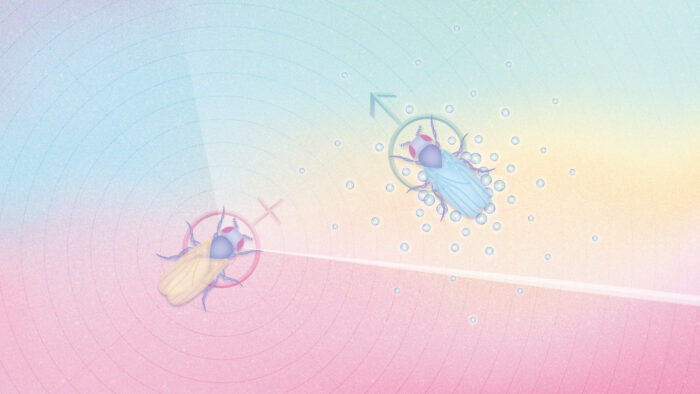Mechanistic insight into neural pathways of Drosophila reveals how smell encodes the identity and position of stimuli

Many animals rely on smell to identify and locate objects in their surroundings and to respond appropriately. To investigate this phenomenon further, Greg Jefferis’ group in the LMB’s Neurobiology Division studied Drosophila flies, the males of which are known to release a pheromone, cis-vaccenyl acetate (cVA), which is sensed by a dedicated olfactory channel and acts as an aphrodisiac in females but promotes aggression in males. Dana Galili, a postdoc in Greg’s group, and István Taisz, a PhD student in the group, used this sex-based difference in pheromone response to determine the first mechanistic explanation of how smell can encode both the identity and the position of a stimuli.
Dana and István examined the Drosophila brain at multiple levels, building circuit models to examine how different aspects of a sensory signal are separated by the brain. Their approach was guided by the recently published synaptic-resolution connectome (a wiring map of brain connections) of the Drosophila adult brain, and its analysis, spearheaded by members of the Greg’s group.
Using genetically engineered flies, the group were able to test the hypotheses they derived from their wiring map. Fluorescent microscopy allowed them to record how specific neural cells responded to stimuli. They then identified which social behaviour these cells represented by changing the activity of the cells.
Examining how female flies use smell to determine stimuli location, the group found that flies are especially sensitive to differences in smell reaching both antennae – the fly’s nostrils – and can use this information to locate a male. Moreover, the researchers determined the mechanism whereby a single neuron increases the left-right contrast, allowing for an enhanced ability to localise the male’s angular direction precisely, despite the tiny spatial difference between antennae.
The group’s findings illustrate how a single sensation – the scent of a male – is broken down into different aspects within the brain, each encoded by a dedicated neural pathway. Their results provide a uniquely comprehensive description of how a single stimulus is decomposed by the brain at synaptic resolution, with a full diagram of connectivity and functionality. The brain’s ability to interpret the surrounding environment relies upon breaking down each stimulus into elemental components and assigning meanings to each of them.
For example, the speed of the male’s movement, it’s location in the space around the female, and the quality of the male as a potential mating partner are all computed separately in the brain, and each can lead to a different response. For instance, the pathway linked to male quality can provoke a female sexual response, whereas the pathway representing male movement does not.
This advanced understanding of the neural response to a single sensory stimulus contributes to a much wider scientific endeavour to fully explain how the healthy brain functions. This is necessary to better understand what goes wrong in diseased or injured brains. Looking ahead, the approach used by Dana and István will serve as a reference point for future work in species with larger brains, which is also a focus for future connectome datasets.
This project was done in collaboration with scientists at the Drosophila Connectomics group, University of Cambridge and the Behavior and Metabolism Laboratory, Champalimaud Foundation.
The work was funded by UKRI MRC, the European Research Council, NeuroNex (National Science Foundation), the Wellcome Trust, EMBO, “la Caixa” Banking Foundation, FCT (Fundação para a Ciência e a Technologia) and The Champalimaud Foundation (Fundação Champalimaud).

In addition, this project has received funding from the European Union’s Horizon 2020 research and innovation programme under grant agreement No 748478 .
Further references
Generating parallel representations of position and identity in the olfactory system. Taisz, I., Donà, Münch, D., Bailey, SN., Morris, BJ., Meechan, KI., Stevens, KM., Varela-Martínez, I., Gkantia, M., Schlegel, P., Ribeiro, C., Jefferis, GSXE., Galili, DS. Cell
Previous Insight on Research
A map to show the way to sense smell, temperature, and humidity
Decoding how detection of odours leads to diverse behaviours in flies